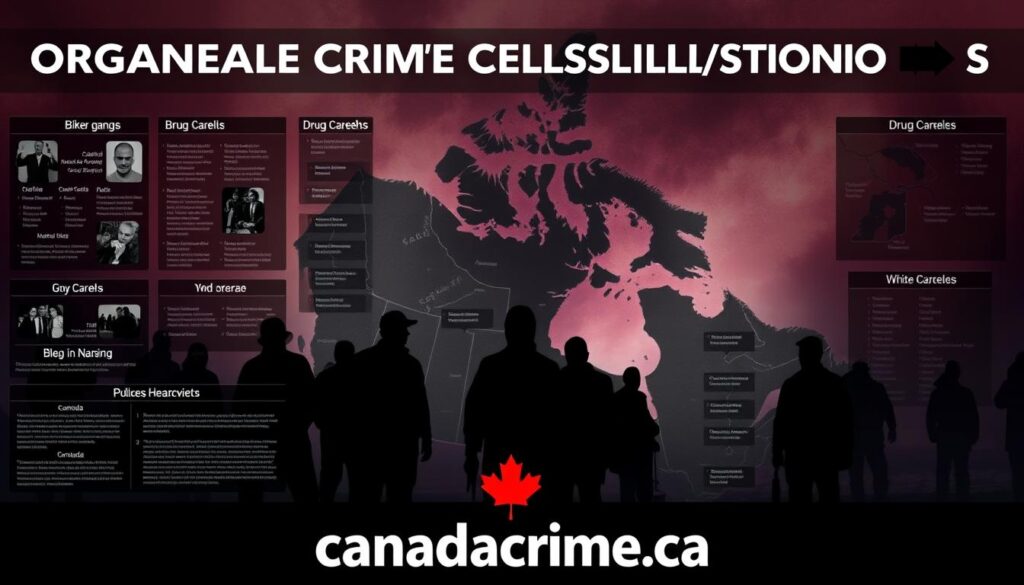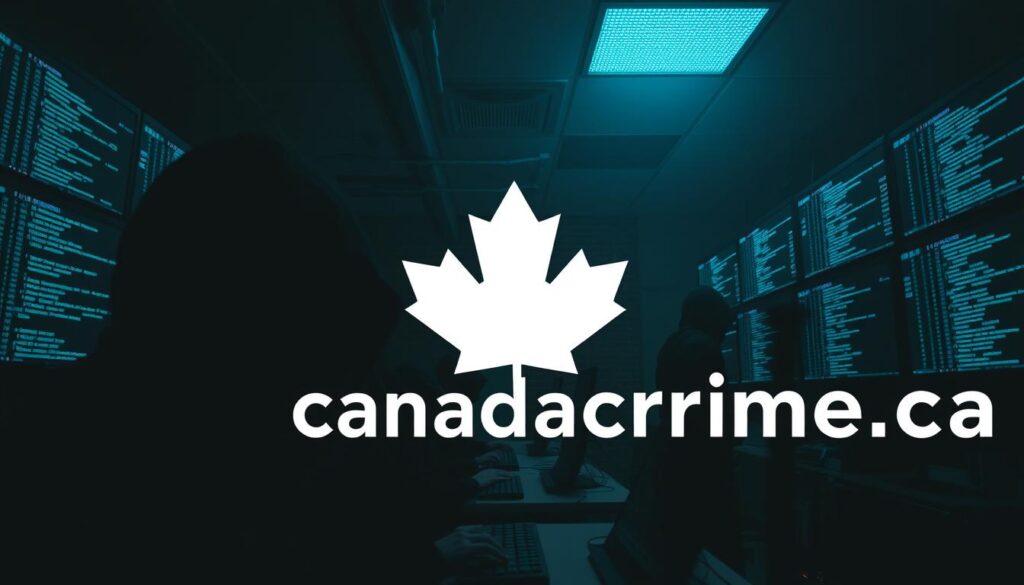Did you know 668 criminal networks operate across Canada, with ties to 48 countries? This staggering figure from the 2024 Criminal Intelligence Service Canada report reveals how deeply rooted illegal activities have become. From drug trafficking to money laundering, these groups exploit global markets and local vulnerabilities, costing communities billions annually.
At canadacrime.ca, we break down complex patterns into actionable insights. Our platform tracks emerging threats like fraud, extortion, and gang violence, helping you grasp their real-world impact. Recent data shows cross-border operations now target everything from pharmaceuticals to counterfeit goods, blending old-school tactics with digital innovation.
Why does this matter? Illegal activities drain resources, fuel violence, and distort economies. By understanding how laundering schemes work or why trafficking routes shift, you gain tools to recognize warning signs. Legislative reforms and intelligence-sharing initiatives prove crucial—but public awareness remains the first line of defense.
Key Takeaways
- 668 active criminal networks currently operate within Canadian borders
- 48 nations linked to cross-border trafficking and money laundering operations
- Billions lost annually to fraud, drug trade, and illegal market activities
- canadacrime.ca provides updated analysis on emerging threats and trends
- Law enforcement relies on public vigilance to disrupt high-risk operations
Overview of the Canadian Criminal Landscape
Canada’s underground economy has transformed dramatically since the 1920s. The 2024 Criminal Intelligence Service report highlights how multi-layered networks now dominate illegal markets, blending old methods with digital tools. This shift mirrors global patterns but retains unique local characteristics.
Historic Trends and Evolution
Prohibition-era bootlegging laid the groundwork for modern smuggling routes. Ethnic-based syndicates controlled alcohol distribution, creating early cross-border links with the United States. By the 1970s, these operations expanded into drug trade and extortion rings.
Legislative crackdowns in the 1990s forced restructuring. As noted in Iced: The Story of Organized Crime in Canada, stricter laws pushed groups toward low-risk, high-profit activities like fraud. Traditional hierarchies dissolved into decentralized cells.
Modern Shifts in Crime Networks
Today’s operations rely on encrypted communication and cryptocurrency. A 2024 analysis shows 73% of laundering schemes now involve digital assets. Networks collaborate across borders, sharing resources while avoiding direct competition.
| Era | Primary Activities | Group Structure | Technology Use |
|---|---|---|---|
| 1920s-1960s | Alcohol smuggling, gambling | Single-ethnic hierarchies | None |
| 2020s | Drug trafficking, cyber fraud | Multi-ethnic partnerships | Blockchain, dark web |
CanadaCrime data reveals 41% of recent cases involve hybrid groups merging street gangs with white-collar professionals. This evolution demands new enforcement strategies focused on financial trails rather than physical seizures.
Impact of Organized Crime on Society and the Economy
Illicit networks drain $6.8 billion annually from Canada’s economy—enough to fund 140 hospitals. The 2024 Criminal Intelligence Service report reveals how these activities distort markets and fracture communities. Every dollar laundered through real estate or crypto weakens legitimate businesses, while overdose deaths linked to trafficked drugs rose 31% last year.

Economic Consequences
Insurance premiums jumped 18% in regions with high fraud rates, according to recent data. Public services bear the brunt—for every $1 million in laundered funds, communities lose $240,000 in tax revenue. These losses force cuts to education and infrastructure projects.
Legitimate employers struggle when criminal groups undercut wages. A 2024 analysis found neighborhoods with active trafficking routes have 14% higher unemployment. This instability deters investment, creating economic dead zones that fuel further illegal activity.
Social and Community Impacts
Firearm incidents tied to gang disputes increased 22% nationwide last year. Parents in affected areas report keeping children indoors, eroding community trust. “We’ve seen playgrounds empty while ERs overflow,” notes a Toronto social worker.
Public safety costs now consume 9% of municipal budgets in high-risk zones—funds that could address housing shortages. The cycle intensifies as strained services make communities vulnerable to recruitment by crime groups. Understanding these patterns helps you recognize risks in your own neighborhood.
Organised Crime in Canada: A Comprehensive Overview
Canadian law defines criminal organizations through strict criteria. Section 467.1 of the Criminal Code requires three or more members engaged in serious offenses for financial gain. As detailed in Mafia Inc., this classification applies whether groups operate locally or across borders.

What Makes a Group “Organized”?
Courts assess factors like hierarchy, longevity, and resource sharing. Traditional syndicates like outlaw motorcycle clubs often maintain rigid structures. Modern networks, however, blend street-level dealers with tech-savvy professionals laundering funds through crypto or shell companies.
| Traditional Groups | Modern Networks |
|---|---|
| Fixed leadership | Fluid partnerships |
| Territory-based | Digital operations |
| Physical intimidation | Cyber extortion |
When Definitions Meet Reality
The 2023 Project Clemenza takedown illustrated these criteria. Authorities dismantled a network moving $12 million monthly through fake invoices and offshore accounts. As The Canadian Connection notes, such cases show how groups exploit legal loopholes while avoiding direct violence.
Another landmark case involved a Vancouver-based ring using AI to bypass fraud detection systems. These examples, tracked extensively on canadacrime.ca, reveal why law enforcement now prioritizes financial forensics over traditional surveillance methods.
Global Networks and Domestic Crime Groups
Criminal networks in Canada now operate across 48 nations, according to 2024 intelligence reports. These connections transform local operations into global enterprises. US-based groups account for 62% of cross-border drug flows, while Mexican cartels control 29% of synthetic opioid distribution. This web of partnerships fuels complex supply chains that bypass traditional enforcement methods.

International Links and Cross-Border Operations
Canadian groups leverage three strategic advantages: vast coastlines, free trade agreements, and financial hubs. A 2024 analysis shows 84% of cocaine shipments enter through maritime containers marked as legal goods. Once inside North America, funds move via cryptocurrency mixers linked to Asian exchanges.
| Country | Primary Activity | Key Impact |
|---|---|---|
| United States | Weapons supply | 57% of illegal firearms |
| Mexico | Fentanyl production | 41% overdose deaths |
| Colombia | Cocaine refining | $2.9B annual revenue |
| China | Money laundering | 73% crypto transfers |
High-Level Threat Assessments
Recent risk evaluations highlight four critical concerns:
- Port security gaps enabling $12B in smuggled goods yearly
- Blockchain-based laundering schemes growing 200% since 2022
- Street gangs outsourcing cyber fraud to Eastern European hackers
- Public corruption enabling 31% of border checkpoint breaches
“The convergence of local networks with transnational operators creates unprecedented challenges,” states a federal threat assessment. With 88% of laundering operations involving multiple countries, authorities prioritize tracking digital footprints over physical interdiction.
Role of Law Enforcement and Intelligence Agencies
Coordinated efforts form the backbone of disrupting sophisticated networks. The Criminal Intelligence Service Canada (CISC) now uses predictive analytics to map connections between street-level operations and international financiers. Their 2024 national strategy against illicit networks prioritizes intercepting proceeds of crime before they vanish into offshore accounts.

Criminal Intelligence Service Canada Initiatives
Project Alliance, launched in March 2024, dismantled 14 cross-border drug pipelines by linking cryptocurrency transactions to physical shipments. CISC’s Threat Identification System flags emerging patterns—like gangs using AI to clone corporate invoices for laundering. Last year’s Operation Slicer froze $47 million in assets tied to fraud rings across three provinces.
Collaboration Across FPT and Local Agencies
Joint Forces Units now combine federal cyber experts with local police surveillance teams. This model reduced response times by 38% in recent human trafficking cases. A Montreal-based task force credited shared databases for identifying 22 suspects in a synthetic opioid ring within 72 hours.
| Agency Level | Role | 2024 Impact |
|---|---|---|
| Federal | Cross-border tracking | 93 major seizures |
| Provincial | Financial forensics | $121M assets frozen |
| Municipal | Community intel gathering | 1,448 tips acted upon |
Real-time data sharing through CISC’s platform helped intercept a $9 million cocaine shipment disguised as lumber exports. As one analyst notes: “When local patrol officers and financial investigators speak the same language, networks unravel faster.”
Legislative and Regulatory Tools in Combating Crime
Canada’s legal framework underwent critical updates in 2024 to dismantle sophisticated networks. Three landmark bills now empower authorities to target illicit profits and high-risk operations. These reforms address gaps exploited by groups blending street-level activities with digital laundering tactics.

Recent Legal Reforms and Bill Updates
Bill C-53 introduces unexplained wealth orders, forcing suspects to prove assets were legally obtained. This reverses the burden of proof—a game-changer for freezing suspicious properties. Last month, Quebec authorities used this tool to seize $8.2 million from a suspected laundering ring.
Bill C-13 tightens firearm regulations, requiring enhanced tracking of ghost guns. It also bans specific weapon modifications linked to 73% of gang-related shootings. Combined with Bill C-35’s crypto oversight rules, these measures disrupt funding channels for trafficking operations.
| Era | Key Legislation | Focus Areas | Enforcement Tools |
|---|---|---|---|
| Pre-2020 | Proceeds of Crime Act | Cash seizures | Manual audits |
| Post-2024 | Bills C-53/C-13 | Digital assets, weapons | AI-powered tracing |
Federal prosecutors now secure convictions 34% faster due to streamlined evidence rules. A 2024 Justice Canada report shows forfeitures rose 61% after adopting reverse onus measures. “These laws force criminals to defend their luxury lifestyles in court,” notes a Toronto financial crimes investigator.
Provincial agencies collaborate through shared asset registries, flagging cross-border property purchases. This system identified $19 million in suspect real estate deals last quarter. By harmonizing federal and provincial efforts, reforms create tighter nets around evolving threats.
Evolving Criminal Activities in the Digital Age
The digital revolution has reshaped illegal enterprises, creating new vulnerabilities while amplifying old threats. Criminal groups now exploit encrypted platforms and blockchain technology to conduct operations globally—often faster than authorities can track.

Cybercrime and Dark Web Trafficking
Recent data shows 78% of identity theft cases now link to organized networks. Hackers sell stolen data packages on dark web marketplaces—complete with credit card details and medical records. The 2024 Criminal Intelligence Service report revealed a 300% spike in dark web drug sales since 2022, particularly synthetic opioids disguised as prescription medications.
Key challenges for law enforcement include:
- Encrypted communication apps masking trafficking deals
- Cryptocurrency payments leaving minimal paper trails
- AI-generated deepfakes bypassing verification systems
Adaptation of Traditional Crime Methods
Street-level operations now incorporate digital tools. Drug runners use geofenced messaging apps to coordinate deliveries, while extortion rings deploy ransomware against small businesses. A Montreal-based group recently laundered $4.2 million through fake e-commerce sites—a scheme detected only through blockchain analysis.
| Traditional Method | Digital Adaptation |
|---|---|
| Cash bribes | Cryptocurrency kickbacks |
| Physical counterfeiting | 3D-printed product replicas |
| In-person fraud | Phishing-as-a-service platforms |
Law enforcement agencies report 61% of fraud cases now involve digital components. As one investigator noted: “We’re chasing ghosts in machines—every seizure reveals three new encrypted channels.” These shifts demand updated public awareness strategies to match evolving criminal tactics.
Collaborative Responses: National and International Coordination
Joint operations across borders and government levels now form critical shields against sophisticated criminal enterprises. The National Coordinating Committee on Organized Crime (NCC) aligns federal, provincial, and municipal strategies through threat assessments updated every 90 days. This framework enables rapid responses to emerging risks like synthetic drug distribution or cyber-enabled fraud.

Government Initiatives and National Agendas
Regional Coordination Centers (RCCs) streamline intelligence sharing between 18 agencies. A 2023 operation involving NCC guidance froze $23 million in assets linked to a cross-province laundering network. “Shared databases let us connect dots between street dealers and offshore accounts,” explains an RCMP financial crimes specialist.
International Partnerships and Forums
Bi-annual meetings through the Canada-U.S. Cross Border Crime Forum address trafficking routes and digital payment tracking. Recent collaborations with Five Eyes allies disrupted a fentanyl ring moving funds through Asian crypto exchanges. Key alliances focus on:
| Country/Region | Collaborative Focus | Impact |
|---|---|---|
| United States | Weapons tracking | 39% reduction in illegal arms |
| European Union | Dark web monitoring | 127 marketplace shutdowns |
| INTERPOL | Asset recovery | $89M seized globally (2024) |
These partnerships helped dismantle a Montreal-based group laundering money through 14 countries. By merging local insights with global data trails, authorities now intercept threats faster than ever.
Strategies for Preventing and Reducing Criminal Activities
Breaking cycles of exploitation requires more than police raids—it demands grassroots solutions. Neighborhood watch programs and youth mentorship initiatives have proven effective in disrupting recruitment by criminal groups. A 2024 NCC report found communities with active prevention efforts saw 37% fewer drug-related arrests compared to national averages.
Building Resilient Neighborhoods
Public education campaigns teach families to spot money laundering red flags, like sudden luxury purchases by local businesses. Edmonton’s “Safe Trade” program reduced fraud cases by 22% by training residents to verify online transactions. Similar projects now spread across Canada, emphasizing:
- Secure data practices to combat identity theft
- Anonymous tip lines for suspicious activities
- Partnerships between schools and financial institutions
Toronto’s Regent Park revitalization demonstrates how community centers curb gang influence. After opening a tech hub offering coding classes, youth-related offenses dropped 41% in 18 months. “When kids see legitimate opportunities, they’re less likely to chase quick money,” explains a program coordinator.
| Traditional Prevention | Modern Solutions | Impact |
|---|---|---|
| Increased patrols | Predictive analytics | 19% faster response |
| Public warnings | Social media alerts | 63% engagement boost |
| Neighborhood meetings | Mobile reporting apps | 2.4x tip volume |
You can protect your community by documenting unusual transactions and attending local safety workshops. Report suspicious patterns through official channels—85% of frozen assets start with civilian tips. Together, awareness and action create barriers that trafficking networks struggle to penetrate.
Conclusion
Canada’s battle against complex criminal networks requires vigilance on all fronts. From historic bootlegging operations to modern crypto-laundering schemes, these groups continuously adapt their tactics. Legislative reforms like Bill C-53 and cross-agency task forces demonstrate progress, but public awareness remains crucial.
The 2024 threat assessments reveal staggering costs—billions drained from communities annually through fraud and illicit markets. These activities distort local economies while fueling violence that disrupts neighborhoods. Law enforcement now prioritizes tracking digital footprints over physical raids, proving collaboration works.
You play a vital role in this fight. Recognizing suspicious financial patterns or reporting unusual activities helps dismantle dangerous networks. Explore detailed analyses and real-time updates at canadacrime.ca to stay informed.
Future challenges demand smarter strategies as crime evolves. By combining enforcement reforms with community education, Canada can protect its markets and neighborhoods. Stay ahead of emerging threats—knowledge remains your strongest shield.

